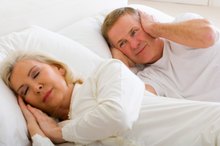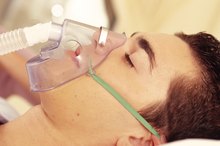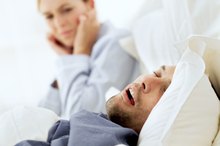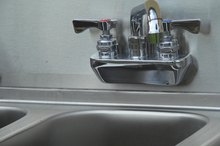How Does a BiPAP Machine Work?
People diagnosed with obstructive sleep apnea, OAS, seldom get a good night’s sleep. As the muscles at the back of their throats relax, the upper airways may narrow or collapse during inspiration. Snoring, followed by airway collapse, leads to periods of intermittent pauses in breathing known as apnea. When the pauses are long enough or frequent enough, the brain is deprived of oxygen and it signals the body to cough, choke or gasp to re-start the breathing cycle. The person may awaken and resume normal breathing, only to repeat the cycle, according to the Mayo Clinic. A bilevel positive airway pressure, or BiPAP, machine can effectively stop this dysfunctional sleep cycle.
If you are experiencing serious medical symptoms, seek emergency treatment immediately.
Identification
Although many people are familiar with CPAP, or continuous positive airway pressure, machines, BiPAP therapy is less known. Both types of machines have a programmable unit that compresses air, masks, headgear that attaches to the face and tubing to connect the mask and machine. A BiPAP machine delivers compressed air, as a CPAP unit does, but it features two different pressures.
Functions
The Best CPAP BiPAP Masks for High Pressure
Learn More
BiPAP machines are programmed to deliver air at an inhalation pressure, or IPAP, when the person inhales through the mask and tubing. When the person exhales, the BiPAP unit senses the change and switches to a lower exhalation pressure, or EPAP, according to Emedicine. By providing constant yet variable resistance within the upper airways, BiPAP therapy prevents the airway collapse that leads to snoring and apnea.
Considerations
People who use CPAP have to breathe against constant resistance from the pre-programmed setting, but those who use BiPAP technology don’t have to work as hard to exhale against the lower EPAP. People with significant respiratory disease or those who aren’t able to acclimate to the constant pressure of CPAP may be more comfortable with BiPAP therapy, the Mayo Clinic says.
Benefits
Long-Term Effects From Using a CPAP Machine
Learn More
BiPAP users appreciate a more normal sleep cycle, uninterrupted by apnea and snoring, and their bed partners enjoy a better night’s sleep, too. People who use BiPAP machines say they are more alert, less drowsy, more productive and in a better mood during daytime hours. In addition, MedlinePlus reports, these people say their concentration and memory skills improve with BiPAP therapy. Untreated OAS can cause high blood pressure, stroke, cardiovascular disease and even death. According to the American Association of Oral and Maxillofacial Surgeons, BiPAP therapy reduces these long-term risks 4.
- BiPAP users appreciate a more normal sleep cycle, uninterrupted by apnea and snoring, and their bed partners enjoy a better night’s sleep, too.
- People who use BiPAP machines say they are more alert, less drowsy, more productive and in a better mood during daytime hours.
Tips
It takes time for new BiPAP users to feel comfortable with the sounds of the air compressor, the feel of the mask and headgear and the sight of machinery on the bedside table. The Mayo Clinic recommends that people collaborate with a doctor or sleep care professional to get the best possible fit and most comfortable BiPAP arrangement 1.
Related Articles
References
- Mayo Clinic: Sleep Apnea: Treatment and Drugs
- Emedicine: Noninvasive Ventilation: Treatment and Medication
- Medline Plus: Nasal CPAP
- Panchabhai TS, Mireles cabodevila E, Pioro EP, Wang X, Han X, Aboussouan LS. Pattern of lung function decline in patients with amyotrophic lateral sclerosis: implications for timing of noninvasive ventilation. ERJ Open Res. 2019;5(3).doi.10.1183/23120541.00044-2019
- Hukins C, Murphy M, Edwards T. Dose-response characteristics of noninvasive ventilation in acute respiratory failure. ERJ Open Res. 2020;6(1).doi.10.1183/23120541.00041-2019
- Koga Y, Kaneda K, Fujii N, et al. Comparison of high-flow nasal cannula oxygen therapy and non-invasive ventilation as first-line therapy in respiratory failure: a multicenter retrospective study. Acute Med Surg. 2020;7(1):e461.doi.10.1002/ams2.461
- Donovan LM, Boeder S, Malhotra A, Patel SR. New developments in the use of positive airway pressure for obstructive sleep apnea. J Thorac Dis. 2015;7(8):1323–1342. doi:10.3978/j.issn.2072-1439.2015.07.30
- Ankjærgaard, K.L., Tønnesen, P., Laursen, L.C. et al. Home Non Invasive Ventilation (NIV) treatment for COPD patients with a history of NIV-treated exacerbation; a randomized, controlled, multi-center study. BMC Pulm Med 16, 32 (2016) doi:10.1186/s12890-016-0184-6
- COPD Working Group. Noninvasive positive pressure ventilation for chronic respiratory failure patients with stable chronic obstructive pulmonary disease (COPD): an evidence-based analysis. Ont Health Technol Assess Ser. 2012;12(9):1–51. PMID: 23074437
- Ankaergaard K, Tonnesen P, Laursen L, et al. Home NonInvasive Ventilation (NIV) treatment for COPD patients with a history of NIV-treated exacerbation; a randomized, controlled, multi-center study. BMC Pulmonary Medicine. 2016. 16(1):32.
- Johns Hopkins Medicine. Treatments and Tests: BiPap.
Writer Bio
Sandy Keefe, M.S.N., R.N., has been a freelance writer for over five years. Her articles have appeared in numerous health-related magazines, including "Advance for Nurses" and "Advance for Long-Term Care Management." She has written short stories in anthologies such as "A Cup of Comfort for Parents of Children with Special Needs."







